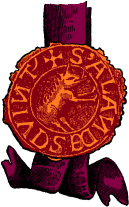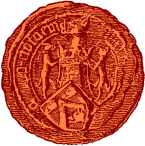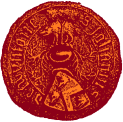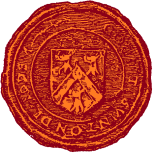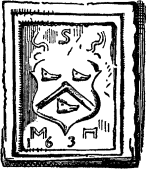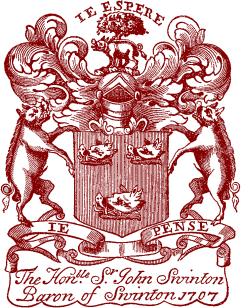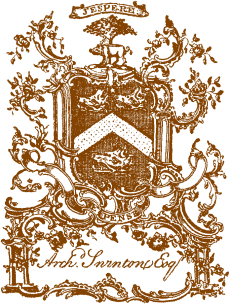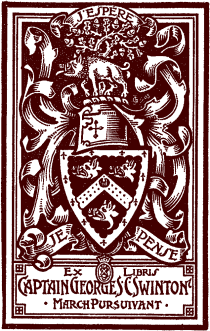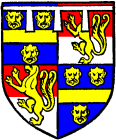 |
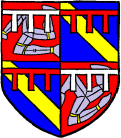 |
| FIG. 691.--Arms of John de la Pole. Earl of Lincoln (son of John, Duke of Suffolk), d. 1487: Quarterly, 1 and 4, azure, a fess between three leopard's faces or; 2 and 3, per fess gules and argent, a lion rampant queue fourché or, armed and langued azure, over all a label argent. (From his seal.) |
FIG. 692.--Arms of William Le Scrope, earl of Wilts (d. 1399): Quarterly, 1 and 4, the arms of the Isle of Man, a label argent; 2 and 3, azure, a bend or, a label gules. (From Willement's Roll, sixteenth century.) |
At Caerlaverock,
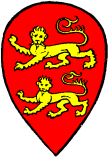 |
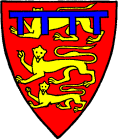 |
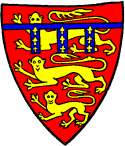 |
| FIG. 700.--King John, before his accession to the throne. (From MS. Cott., Julius, C. vii.) |
FIG. 701.--Edmund "Crouch back," Earl of Lancaster, second son of Henry III. (From his tomb.) His arms are elsewhere given: De goules ove trois leopardes passantz dor, et lambel dazure florete d'or. |
FIG. 702.--Thomas, Earl of Lancaster, d. 1322 (son of preceding): England with a label azure, each point charged with three fleurs-de-lis. (From his seal, 1301.) |
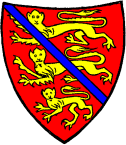 |
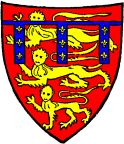 |
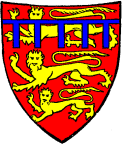 |
| FIG. 703.--Henry of Lancaster, 1295-1324 (brother of preceding, before he succeeded his brother as Earl of Lancaster): England with a bend azure. (From his seal, 1301.) After 1324 he bore England with a label as his brother. |
FIG. 704.--Henry, Duke of Lancaster, son of preceding. (From bis seal, 1358.) |
FIG. 705.--Edward of Carnarvon, Prince of Wales (afterwards Edward II.), bore before 1307: England with a label azure. (Fromhis seal, 1305.) |
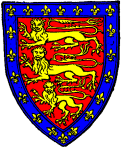 |
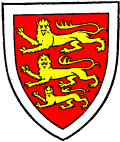 |
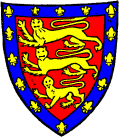 |
| FIG. 706.--John of Eltham (second son of Edward II.): England with a bordure of the arms of France. (From his tomb. ) |
FIG. 707.--Arms of Edmund of Woodstock, Earl of Kent, 3rd son of Edward I.: England within a bordure argent. The same arms were borne by his descendant, Thomas de Holand, Earl of Kent. |
FIG. 708.--Arms of John de Holand, Duke of Exeter(d. 1400): England, a bordure of France. (From his seal, 1381.) |
The grant of an
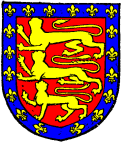 |
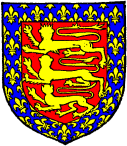 |
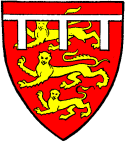 |
| FIG. 709.--John de Holand, Duke of Exeter, son of preceding. Arms as preceding. (From his seal.) |
FIG. 710.--Henry de Holand, Duke of Exeter, son of preceding. Arms as preceding. (From his seal, 1455.) |
FIG. 711.--Thomas of Brotherton, Earl of Norfolk, second son of Edward I.: Arms of England, a label of three points argent. |
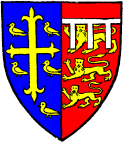 |
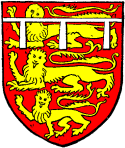 |
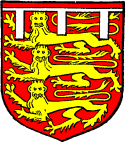 |
| FIG. 712.--Thomas de Mowbray, Duke of Norfolk (d. 1400). (From his seal, MS. Cott., Julius, C. vii., f. 166.) Arms, see page 465. |
FIG. 713.--John de Mowbray, Duke of Norfolk (d. 1432): Arms as Fig. 711. (From his Garter plate.) |
FIG. 714.--John de Mowbray, Duke of Norfolk (d. 1461): Arms as Fig. 711. (From his seal.) |
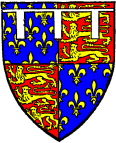 |
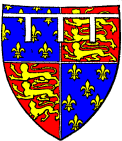 |
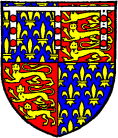 |
| FIG. 715.--Edward the Black Prince: Quarterly, 1 and 4 France (ancient); 2 and 3 England, and a label of three points argent. (From his tomb.) |
FIG. 716.--Richard, Prince of Wales (afterwards Richard II.), son of preceding: Arms as preceding. (From his seal, 1377-) |
FIG. 717.--Edmund of Langley, Duke of York, fifth son of King Edward III.: France (ancient) and England quarterly, a label of three points argent, each point charged with three torteaux. (From his seal, 1391.) His son, Edward, Earl of Cambridge, until he succeeded his father, i.e. before 1462, bore the same with an additional difference of a bordure of Spain (Fig. 316). Vincent attributes to him, however, a label as Fig. 719, which possibly he bore after his father's death. |
Marks of difference are never added to an exemplification following upon a Royal Licence after illegitimacy. Marks of difference are to indicate
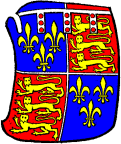 |
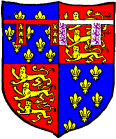 |
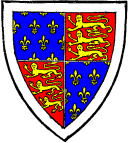 |
| FIG. 718.--Richard, Duke of York (son of Edward, Earl of Cambridge and Duke of York): Arms as preceding. (From his seal, 1436.) |
FIG. 719.--Referred to under Fig. 717. |
FIG. 720.--Thomas of Woodstock, Earl of Buckingham, seventh son of Edward III.: France (ancient) and England quarterly, a bordure argent. (From a drawing of his seal, 1391, MS. Cott., Julius, C. vii.) |
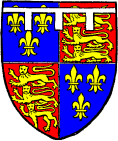 |
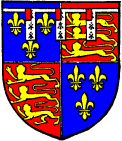 |
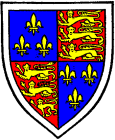 |
| FIG. 721.--Henry of Monmouth, afterwards Henry V.: France (modern) and England quarterly, a label of three points argent. (From his seal.) |
FIG. 722.--Richard, Duke of Gloucester(afterwards Richard III.): A label of three points ermine, on each point a canton gules. |
FIG. 723.--Humphrey of Lancaster, Duke of Gloucester, fourth son of Henry IV.: France (modern) and England quarterly, a bordure argent. (From his seal.) |
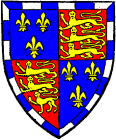 |
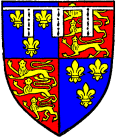 |
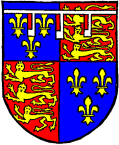 |
| FIG. 724.--John de Beaufort, Earl and Marquis of Somerset, son of John of Gaunt. Arms subsequent to his legitimation: France and England quarterly, within a bordure gobony azure and argent. Prior to his legitimation he bore: Per pale argent and azure (the livery colours of Lancaster), a bend of England (i.e. a bend gules charged with three lions passant guardant or) with a label of France. |
FIG. 725.--Thomas, Duke of Clarence, second son of Henry IV. France and England quarterly, a label of three points ermine. (From his seal, 1413.) |
FIG. 726.--George Plantagenet, Duke of Clarence, brother of Edward IV.: France and England quarterly, a label of three points argent, each charged with a canton gules. (From MS. Harl. 521.) |
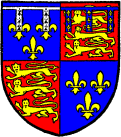 |
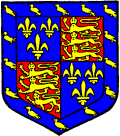 |
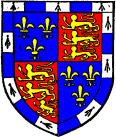 |
| FIG. 727.--John, Duke of Bedford, third son or Henry IV.: France and England quarterly, a label of five points, the two dexter ermine, the three sinister azure, charged with three fleurs-de-lis or. (From MS. Add. 18,850.) |
FIG. 728.--Jasper Tudor, Duke of Bedford: France and England quarterly, a bordure azure, charged with martlets or. (From his seal.) Although uncle of Henry VII., Jasper Tudor had no blood descent whatever which would entitle him to bear these arms. His use of them is very remarkable. |
FIG. 729.--Thomas de Beaufort, Earl of Dorset, brother of John, Earl of Somerset (Fig. 724): France and England quarterly, a bordure compony ermine and azure. (From his Garter plate.) |


 p. 218, we find the following:--
p. 218, we find the following:--

 the label is repeatedly referred to. Of Sir MAURICE DE BERKELEY it is expressly declared that
the label is repeatedly referred to. Of Sir MAURICE DE BERKELEY it is expressly declared that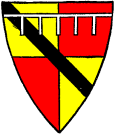



 HENRY of Lancaster, brother and successor of THOMAS, Earl of LANCASTER--
HENRY of Lancaster, brother and successor of THOMAS, Earl of LANCASTER--





 this is engrailed.
this is engrailed.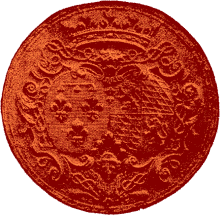

 and the author adds: "If there be any more than six brethren the devise or assignment of further difference only appertaineth to the kingis of armes especially when they visite their severall provinces; and not to the father of the children to give them what difference he list, as some without authoritie doe allege."
and the author adds: "If there be any more than six brethren the devise or assignment of further difference only appertaineth to the kingis of armes especially when they visite their severall provinces; and not to the father of the children to give them what difference he list, as some without authoritie doe allege."






























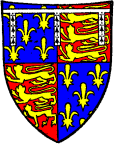

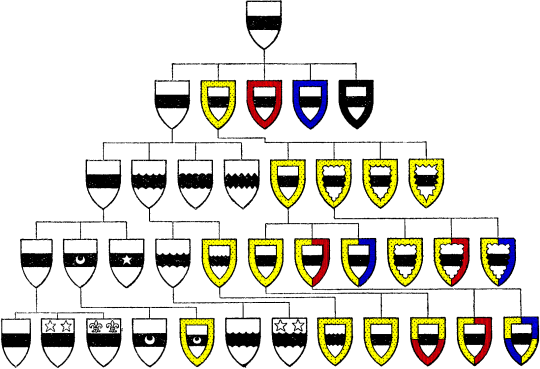
 This is peculiarly instructive, because at no point in the descent covered by the arms referred to is there any doubt or question as to the fact of legitimate descent.
This is peculiarly instructive, because at no point in the descent covered by the arms referred to is there any doubt or question as to the fact of legitimate descent.